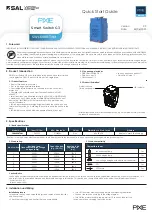
Purpose
Command or Action
(Optional)
Disables the PVLAN feature on the switch.
switch(config)#
no feature
private-vlan
Step 3
You cannot disable PVLANs if there are
operational ports on the switch that are in
PVLAN mode.
Note
This example shows how to enable the PVLAN feature on the switch:
switch#
configure terminal
switch(config)#
feature private-vlan
Configuring a VLAN as a Private VLAN
To create a PVLAN, you must first create a VLAN, and then configure that VLAN to be a PVLAN.
Before You Begin
Ensure that the PVLAN feature is enabled.
Procedure
Purpose
Command or Action
Enters global configuration mode.
switch#
configure terminal
Step 1
Enters VLAN configuration submode.
switch(config)#
vlan
{
vlan-id
|
vlan-range
}
Step 2
Configures the VLAN as either a community, isolated,
or primary PVLAN. In a PVLAN, you must have one
switch(config-vlan)#
private-vlan
{
community
|
isolated
|
primary
}
Step 3
primary VLAN. You can have multiple community and
isolated VLANs.
(Optional)
Removes the PVLAN configuration from the specified
VLAN(s) and returns it to normal VLAN mode. If you
switch(config-vlan)#
no private-vlan
{
community
|
isolated
|
primary
}
Step 4
delete either the primary or secondary VLAN, the ports
that are associated with the VLAN become inactive.
The following example shows how to assign VLAN 5 to a PVLAN as the primary VLAN:
switch#
configure terminal
switch(config)#
vlan 5
switch(config-vlan)#
private-vlan primary
The following example shows how to assign VLAN 100 to a PVLAN as a community VLAN:
switch#
configure terminal
switch(config)#
vlan 100
switch(config-vlan)#
private-vlan community
Cisco Nexus 6000 Series NX-OS Layer 2 Switching Configuration Guide, Release 7.x
35
Configuring Private VLANs
Configuring a VLAN as a Private VLAN
















































